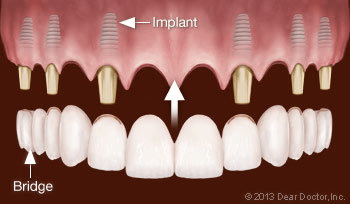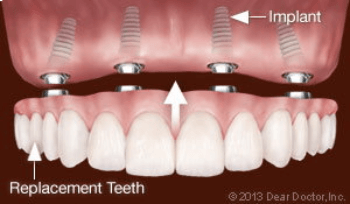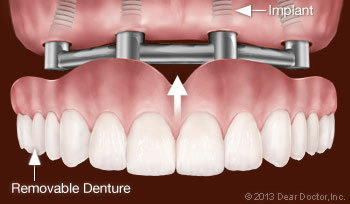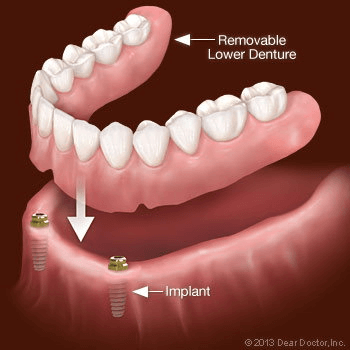Implants
Implants
Implant Site Preparation
The gum tissue is opened to expose the bone area where the implant will be placed. In situations where there is insufficient bone structure, bone grafting may be a recommended procedure. Once healthy bone has been established, a special drill is used to prepare the bone to receive the implant.
Attaching the Post
When the gum tissue is ready, a special post is attached to the implant; it is the support for the new porcelain crown. Today's technologies often include zirconium abutments attached to the implant post, to assure that the new porcelain tooth possesses translucency properties similar to a natural tooth.
Placing the Crown
After impressions are taken a crown is made and shaded to match your existing teeth. The crown fused to the custom post/abutment is then screwed into the implant body. This final prosthetic crown appears as a natural tooth.
Wearing removable dentures will accelerate this process. The longer you go without teeth, the greater the bone loss. If you have lost all of your natural teeth but have not yet experienced significant bone loss, you have a terrific option for full arch, permanent tooth replacement: implant-supported fixed bridgework.
Implant-supported fixed bridgework is a lifelike upper and/or lower arch of false teeth that is virtually indistinguishable from natural teeth. It stays in your mouth all the time, unlike removable dentures. It is securely and comfortably anchored by several dental implants that become an integral part of your jawbone once inserted during a minor surgical procedure done in the dental office.
How It Works
Dental implants are small titanium posts that serve the same purpose as the roots of natural teeth: They anchor replacement teeth to your jawbone. Like natural tooth roots, they lie beneath the gum line and are therefore not visible in the mouth. Because titanium has the unique ability to fuse to living bone, your dental implants actually become a part of your jawbone and help to preserve its volume and density — an important consideration for your health and appearance. When a denture is secured by implants, it does not press down on your bone tissue in a destructive way, and it will remain in position as you eat, speak and smile. This has a very positive impact on quality of life.
It usually takes only two implants to support a lower denture, though every individual is unique and we will have to examine you to determine what would work best in your case. Retaining an upper denture requires a greater number of implants, usually a minimum of four, because of anatomical differences between the upper and lower jaws. If you already wear a denture, we may be able to modify it to become an implant-supported denture. Or we will have a new one made for you.
What to Expect
Dental implant surgery is a simple, routine procedure carried out in the dental office under local anesthesia in most cases. After numbing the area, an appropriate number of implants will be placed in your jaw at precisely planned angles and positions to maximize support and avoid anatomical structures such as nerves and sinuses. Depending on how many implants you will need, the surgery can take anywhere from one to three hours. Most people who have dental implants placed find that any post-operative discomfort can be managed with over-the-counter anti-inflammatory medication such as ibuprofen or acetaminophen.
After surgery, your implants will need to complete the process of fusing to your jawbone (known as osseointegration), before they can support your denture(s). This takes at least six weeks and is different for everyone. During this healing period you will not be without teeth, however, because you can wear a denture that is modified so that it does not overstress the implants. When healing is complete, we will show you how to hook your denture onto the supporting implants (and take it off again) so you can experience the security of teeth that don't move — and all the benefits that go along with them.










